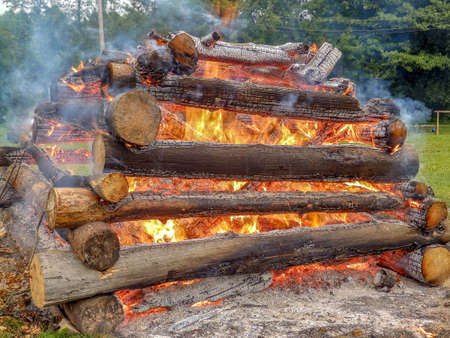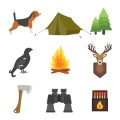Understanding Fire Laws and Permissions in the UK Countryside
Before kindling a campfire amidst the gentle hush of British woodlands or the wild sweep of moorland, it is essential to understand the legal framework governing firecraft in the UK. Rules and permissions can vary dramatically depending on location, so knowledge and preparation are your first acts of respect towards the land and its custodians. In England and Wales, lighting fires is generally not permitted on open access land under the Countryside and Rights of Way Act 2000; even where public footpaths meander through fields or forests, the right to roam does not extend to creating a blaze. Always seek explicit permission from landowners—be they private stewards or organisations such as the National Trust. Scotland offers a more permissive approach thanks to the Scottish Outdoor Access Code, allowing responsible fire use on most unenclosed land, though this still demands careful adherence to safety and environmental guidance. Across all regions, local bylaws or seasonal restrictions may apply, especially during dry spells when wildfire risk soars. By weaving together an awareness of local legislation, an appreciation for regional sensitivities, and open communication with those who care for these spaces, you ensure your campfire experience remains harmonious with both nature and the community.
Choosing the Perfect Spot: Protecting Natural Beauty and Wildlife
Before you strike a match, it’s essential to pause and consider where you’ll build your campfire. Across the rolling hills of the Lake District, the wild woodlands of Scotland, and along the rugged Cornish coast, each natural landscape is precious and fragile in its own way. The right spot not only keeps you safe but also preserves these wild spaces for future adventurers.
Tips for Selecting a Low-Impact Campfire Site
Choosing your fire site with care is an act of respect—for the environment, wildlife, and fellow nature lovers. Here are some guiding principles to help you:
Avoid Sensitive Areas
- Steer clear of peat bogs, heather moorlands, and dry grasslands—these habitats are highly flammable and home to rare species.
- Never light fires in or near designated conservation areas, National Nature Reserves, or Sites of Special Scientific Interest (SSSIs).
Look for Existing Fire Pits
- If previous campers have already created a fire ring or pit, use that spot rather than making a new one. This helps local flora recover elsewhere.
Keep a Safe Distance
- Set up your campfire at least 10 metres from tents, trees, bushes, overhanging branches, and water sources. This minimises the risk of accidental spread and avoids disturbing wildlife at the water’s edge.
Quick Reference Table: Safe Campfire Site Selection
| Site Feature | Recommended Action |
|---|---|
| Dry grass/heath/peat | Avoid completely due to high fire risk |
| Designated conservation area | No fires allowed—respect signage |
| Woodland floor with leaf litter | Select a clear spot; remove debris first |
| Existing stone fire ring | Use if available; don’t create new scars |
The British Countryside Code Reminder
Always follow the Countryside Code: “Leave no trace” is more than a motto—it’s a promise to protect our ancient hedgerows, songbird nesting grounds, and wildflower meadows. By choosing your campfire site wisely, you’re playing your part in keeping Britain’s landscapes as enchanting tomorrow as they are today.

3. Gathering Fuel Responsibly: Sourcing and Sustainability
When it comes to building a campfire in the UK’s wild spaces, gathering fuel is as much an act of respect as it is necessity. The British countryside, with its ancient woodlands and delicate heathlands, asks for a gentle hand and thoughtful choices. Always begin by seeking out only dead and fallen wood – those branches scattered on the forest floor, already surrendered by the tree. These twigs and logs are nature’s offering, rich with character from their time amongst moss and leaf-litter, and their use avoids disrupting the living fabric of the woodland.
Never cut or break branches from standing trees, not even those that appear lifeless. Even seemingly dead limbs can provide habitat for insects or nesting birds. In many parts of the UK, such as national parks or Sites of Special Scientific Interest (SSSI), damaging trees is not just poor form—it may be illegal, carrying hefty fines. Instead, wander quietly through your chosen spot, taking only what you truly need, leaving plenty behind for wildlife and the gentle cycle of decay that nourishes future growth.
Whenever possible, consider sourcing sustainable firewood before your trip. In Britain, many farm shops or local suppliers offer seasoned logs harvested from managed woodlands—where each felled tree is balanced by careful replanting. Bringing your own wood reduces pressure on sensitive habitats and ensures you’re burning timber that won’t introduce pests or diseases to native forests. If you’re gathering on-site, stick to small pieces that burn cleanly; large logs rarely catch well and are best left to return to earth undisturbed.
By embracing these mindful practices, your campfire becomes more than warmth and comfort; it becomes part of a tradition rooted in stewardship—a way to enjoy the wild while keeping its beauty intact for generations yet to gather under the same canopy.
4. Building and Maintaining a Safe Fire
Creating a campfire in the UK countryside is as much about care as it is about comfort. When done mindfully, building a fire becomes an act of respect for nature, ensuring warmth and nourishment without leaving a trace. Here’s a step-by-step guide to constructing and maintaining a safe fire, with special attention to British landscapes and local weather patterns.
Step 1: Choosing the Right Spot
Select an established fire ring if one exists—never scar untouched ground. Ensure your site is at least 10 feet away from tents, overhanging branches, dry grass, or bracken. Always consider prevailing wind direction; position your fire so smoke drifts away from camp and fellow campers.
Step 2: Preparing the Fire Circle
If permitted to build your own, create a fire circle by clearing turf down to mineral soil and surrounding it with stones. This not only marks the boundary but helps contain embers. In the UK, where rainfall is frequent but sudden dry spells can increase risk, this precaution is vital.
Step 3: Constructing Your Fire
| Purpose | Recommended Fire Type | Benefits |
|---|---|---|
| Warmth | Pyramid or log cabin fire | Steady heat output, controlled flame size |
| Cooking | Keyhole or platform fire | Even surface for pots and pans, easy ash removal |
Start with small twigs (kindling), gradually adding larger sticks as the fire catches. Use only dead wood found on the ground—never cut live branches. Avoid burning rubbish or plastics, which are harmful to both wildlife and air quality.
Step 4: Managing Sparks and Embers
The UKs often breezy conditions require vigilance. Stack fuel low and flat to prevent high flames that can scatter embers. Keep a bucket of water or damp sand close by at all times. Regularly check for stray sparks beyond your fire circle, especially if wind picks up unexpectedly.
Handy Tips for Spark Control
- Avoid burning pine or other resinous woods—they pop and send out embers.
- If wind shifts, reduce fire size immediately.
- Dampen surrounding area with water if conditions are particularly dry.
A Final Word on Safety and Courtesy
Never leave your fire unattended, even briefly. Before you depart or turn in for the night, douse the flames thoroughly until cold to the touch—remember, “if it’s too hot to touch, it’s too hot to leave.” With mindful practice, your campfire becomes a gentle companion rather than a hazard—a warm glow against the wild British dusk.
5. Extinguishing and Clearing Up: Leave No Trace
As the evening draws to a gentle close and the embers of your campfire begin to wane, it’s essential to embrace the principle of leaving no trace—a true mark of respect for the British countryside.
How to Thoroughly Put Out Your Fire
After soaking in the warmth and camaraderie, take care to extinguish your fire completely. Begin by slowly pouring water over the embers, stirring with a sturdy stick as you go, until every last spark is doused. Listen closely for that distinctive hissing—there should be no sound at all when you’re finished. If water is scarce, use damp earth or sand, though water is always preferable to ensure every coal is cold to the touch.
Disposing of Ashes Safely
Once cool, scatter the ashes thinly over a wide area well away from vegetation and waterways. This helps prevent any accidental scorching or harm to delicate habitats. Never bury hot ashes; they can smoulder unseen and cause underground fires, especially in dry heaths or moorlands so beloved across Britain.
Restoring the Campsite’s Natural State
With your fire safely out, turn your attention to restoring the campsite. Gather any leftover wood and return it neatly to its original spot or stack it discreetly for future visitors. Re-cover any disturbed ground with leaf litter, twigs or turf, blending your presence into the wild tapestry once more. Remove all litter, even biodegradable scraps, as local wildlife can be adversely affected. By treading lightly and leaving the site pristine, you honour both nature and those who will follow in your footsteps—a quiet testament to responsible firecraft amidst the enduring beauty of our landscapes.
6. Embracing Campfire Etiquette and Local Traditions
There is something deeply British about gathering round a campfire, where the gentle glow softens the edges of the night and draws us closer in quiet camaraderie. In the UK, outdoor culture is steeped in a subtle appreciation for peace, community, and respect—qualities that shape our approach to firecraft as much as any practical skill. When we practise responsible firecraft, we are not just lighting flames; we are tending to traditions that honour both the landscape and those who share it with us.
The art of enjoying a campfire here often lies in its restraint. Unlike rowdy bonfires or raucous gatherings, British campfire etiquette values quietude—a kind of mindful presence that allows everyone nearby to enjoy the natural sounds of dusk: the soft hoot of an owl, or the wind weaving through ancient oaks. Keeping conversation gentle and music low respects fellow campers who may be seeking their own moments of tranquility beneath the stars.
Community spirit also sits at the heart of British outdoor life. Sharing stories or a simple cup of tea round the fire becomes an act of inclusion, fostering connection while remaining sensitive to individual space. It is customary to invite others to join but never to intrude, always reading the mood of the group and ensuring no one feels left out or overwhelmed by boisterous behaviour.
Respect for others extends beyond immediate company. When building a campfire, position it thoughtfully so smoke drifts away from neighbouring tents or picnic spots. Keep noise to a minimum after dark and extinguish your fire well before leaving or turning in for the night—small gestures that weave together a tapestry of consideration and care across campsites.
In embracing these local traditions, we cultivate not only safe and respectful fire practices but also a richer experience of British nature—a slow, mindful enjoyment that lingers long after embers fade. To gather responsibly around a campfire is to become part of a living heritage: one that celebrates both solitude and togetherness, gentle warmth and enduring stewardship of the land.

